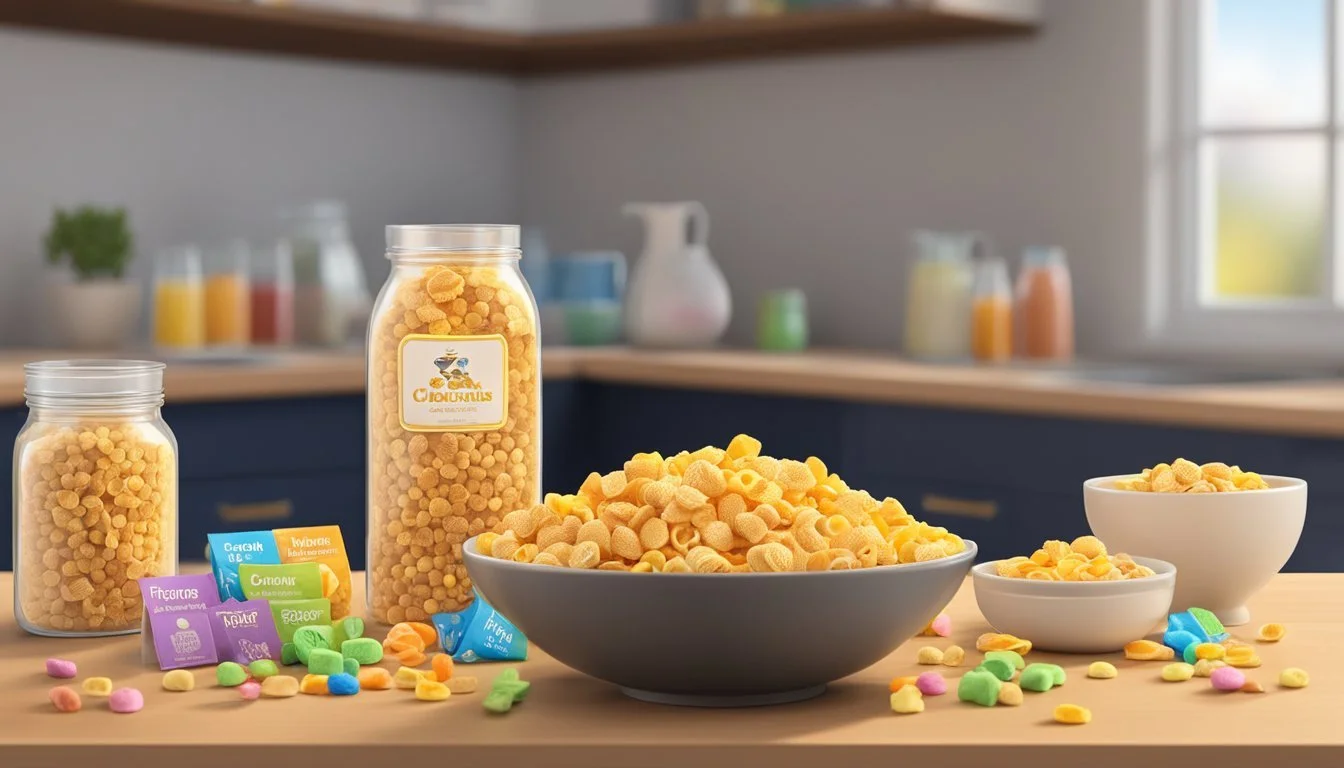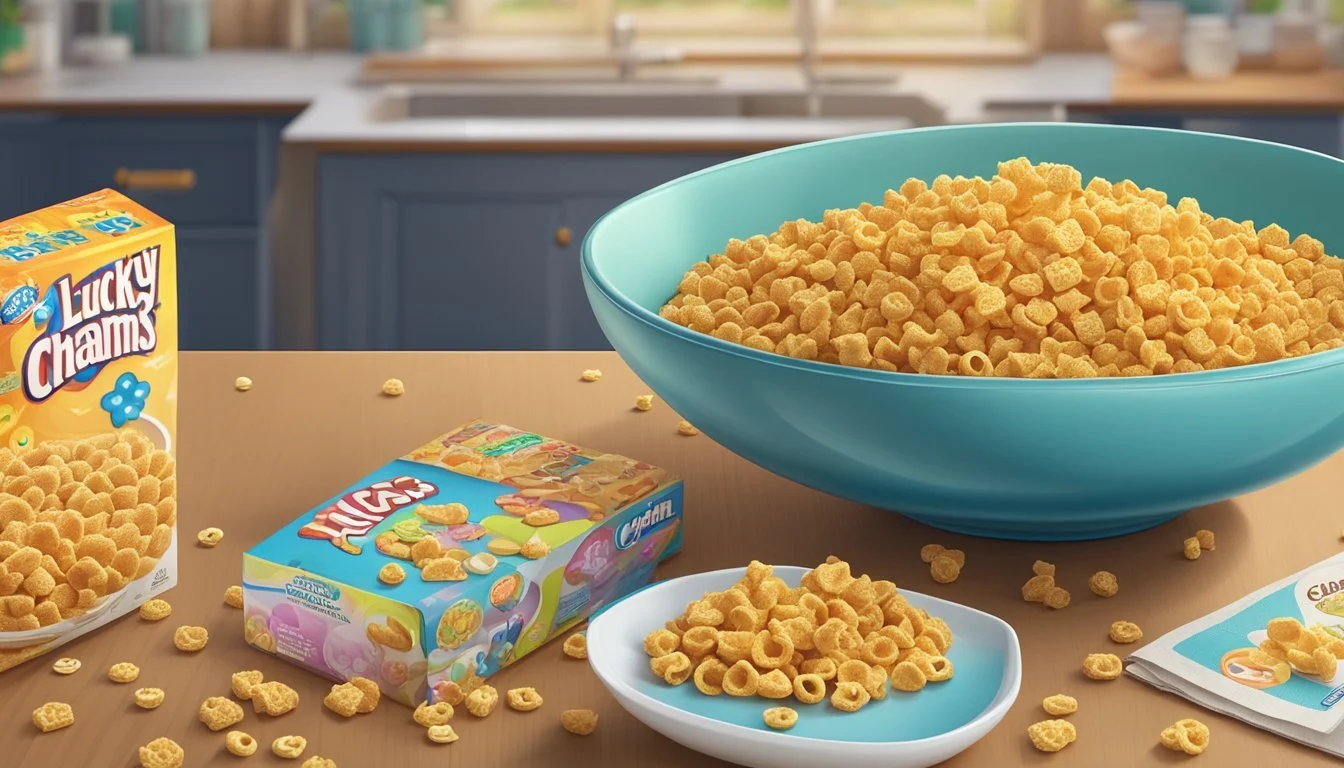Honeycomb vs Lucky Charms
A Comparative Breakfast Cereal Guide
This Article is Part of Our Breakfast Cereal Guide with Details on Honeycomb Nutrition and Lucky Charms Nutrition
When it comes to choosing a breakfast cereal, taste, nutrition, and texture often play key roles. Honeycomb and Lucky Charms, two popular breakfast options, stand out for different reasons. Honeycomb boasts complex carbohydrates, with 14.0 grams per serving, while Lucky Charms provides 12.0 grams. If you’re prioritizing nutrients, Lucky Charms edges out Honeycomb with higher daily need coverage for essential vitamins and minerals like Iron, Zinc, and various B vitamins. Nevertheless, each cereal offers a unique eating experience influenced by its ingredients and nutritional content.
For those drawn to the sweet and nostalgic, Lucky Charms is known for its colorful marshmallow shapes and enriched nutrient profile. Honeycomb, on the other hand, appeals with its honey-flavored crunchy puffs and marginally higher carbohydrate content. Both cereals deliver a quick and convenient breakfast option, but their differences could sway individual choices based on dietary needs and personal preferences.
Understanding the nutritional landscape of these cereals can significantly impact breakfast decisions. Evaluating factors like vitamin content, sugar levels, and overall nutritional value helps families make informed choices for their morning meals.
Background on Honeycomb and Lucky Charms
Honeycomb and Lucky Charms are two iconic cereals with unique characteristics and brand histories. They offer distinct flavor profiles and have captured significant market presence over the years.
Origin and Manufacturer
Honeycomb was introduced by Post Consumer Brands in 1965. Known for its honey-flavored hexagonal pieces, Honeycomb quickly became popular in households. Post, a well-known name in the cereal industry, has maintained its production ever since.
Lucky Charms, launched by General Mills in 1964, is renowned for its colorful marshmallows and oat pieces. Created to appeal to children, Lucky Charms became famous with its catchphrase, "Magically Delicious," and its various marshmallow shapes like Green Clovers and Pink Hearts.
Brand Presence in the Market
Honeycomb and Lucky Charms are prominent players in the grocery store cereal aisle. Honeycomb has consistently attracted consumers with its distinctive texture and honey flavor. Although Honeycomb hasn't significantly changed its formula over the years, it has remained a favorite.
Lucky Charms holds a strong position in the market, particularly among younger audiences. Its unique themed marshmallows and regular promotional tie-ins keep it a relevant and fun choice. General Mills has continuously promoted Lucky Charms, maintaining its appeal through various decades.
Characteristic Flavors and Themes
Honeycomb features a mild, sweet honey flavor and a crunchy texture. The cereal is recognized for its oversized hexagonal shapes, which set it apart visually and texturally from other cereals.
Lucky Charms is famous for its combination of toasted oat pieces and marshmallow shapes that add bursts of color and sweetness. Each marshmallow shape is part of a magical theme, contributing to its whimsical appeal. The cereal’s flavor profile—an interplay of sweetness from marshmallows and the subtlety of oats—remains iconic.
Both cereals have cultivated dedicated fan bases who have their preferred breakfast choice between Honeycomb’s simple sweetness and Lucky Charms' playful, magically delicious experience.
Nutritional Comparison
Honeycomb and Lucky Charms cereals vary significantly in their nutritional content. The key differences lie in their macronutrients, vitamin and mineral content, and their suitability for different dietary needs.
Macronutrient Profiles
Honeycomb provides 14.0 grams of complex carbohydrates per serving, while Lucky Charms has 12.0 grams. Protein content is another differentiator; Honeycomb has a slightly lower protein content.
Per Serving Comparison:
Honeycomb: 14g carbs, 1g protein
Lucky Charms: 12g carbs, 2g protein
Calories and fats are notably similar, with slight variations. Honeycomb has fewer sugars compared to Lucky Charms, which is higher in simple sugars.
Vitamins and Minerals Content
Lucky Charms is richer in several key vitamins and minerals compared to Honeycomb. Specifically, Lucky Charms has higher levels of Iron, Zinc, Vitamin B6, Folate, Vitamin B12, Vitamin B3, Vitamin B1, Calcium, and Vitamin C.
Vitamin and Mineral Comparison:
Iron: Lucky Charms provides 173% more than Honeycomb.
Calcium and Zinc: Higher in Lucky Charms.
B-Vitamins and Vitamin C: More prevalent in Lucky Charms.
Honeycomb lacks the same density in micronutrients, making it less advantageous in this respect.
Dietary Considerations
For those following a low-carb diet, both cereals might not be the best choice due to their carbohydrate content. However, Honeycomb's higher complex carb content may offer a slower glycemic response.
Low Calories Diet:
Honeycomb has marginally lower calorie content per serving.
Low Glycemic Index Diet:
The higher complex carbs in Honeycomb may be more suitable.
Health Impact
When considering health impacts, Lucky Charms has advantages in micronutrient density. However, its higher sugar content may not be ideal for those managing blood sugar levels.
Cholesterol and Fats:
Both cereals are low in fats and cholesterol.
Trans fats and saturated fats are minimal in both.
For a healthy breakfast choice aimed at nutritional completeness, Lucky Charms may be preferred for its enriched vitamins and minerals, despite its higher sugar content.
Product Variants and Related Cereals
Honeycomb and Lucky Charms are iconic breakfast cereals with unique flavors and nutritional profiles. This section explores the different product variants within each brand as well as how these cereals compare to similar options offered by other brands.
Within the Brand
Honeycomb offers both its classic version and some limited variants like Honeycomb Big Bites. These variants cater to different taste preferences but maintain the distinctive honey flavor.
On the other hand, Lucky Charms introduces several playful variants such as Chocolate Lucky Charms and Fruity Lucky Charms. Each variant includes the signature marshmallows, adding variety while keeping the nostalgic charm.
Comparisons with Other Brands
When comparing Honeycomb to other cereals, its closest alternatives include Honey Nut Cheerios and Honey Smacks, which also emphasize honey flavor. Honey Nut Cheerios features the added nutritional benefit of heart-healthy oats.
Lucky Charms can be compared to fun, marshmallow-infused cereals like Cocoa Pebbles, Fruity Pebbles, and Reese's Puffs. These cereals offer similar playful and sweet flavors, appealing to children and adults alike. A notable competitor is Cinnamon Toast Crunch, which provides a spiced twist contrasting with Lucky Charms' marshmallow sweetness.
Consumer Preferences and Trends
Consumers are increasingly concerned with the nutritional content and nostalgic appeal of cereals. Market trends and preference factors both play significant roles in shaping the popularity of Honeycomb and Lucky Charms.
Market Trends
The breakfast cereal market has seen shifts in consumer behavior toward healthier options. Low glycemic index diets are gaining traction, encouraging consumers to choose cereals with complex carbohydrates.
Honeycomb offers 14.0 grams of complex carbs per serving compared to 12.0 grams in Lucky Charms.
Trends indicate a rise in demand for cereals rich in vitamins and minerals. For instance, Lucky Charms provides higher daily need coverage scores for nutrients like Iron, Zinc, and Vitamin B12 compared to Honeycomb.
Moreover, the presence of gluten-free options within brands like Cap’n Crunch demonstrates that the market is adapting to dietary restrictions, although neither Honeycomb nor Lucky Charms is gluten-free.
Preference Factors
Consumer preferences for cereals often hinge on flavor, nostalgia, and health benefits. Lucky Charms retains popularity due to its unique flavor and childhood nostalgia, attracting both children and adults.
Honeycomb, while less enriched in certain vitamins and minerals, appeals to those seeking less sugary options.
Parents often prefer cereals with higher nutritional value for their children. Lucky Charms' coverage of essential nutrients can make it a favored choice despite its sugar content.
Texture is another factor; the crunchy consistency of Honeycomb might appeal to those who enjoy a more substantial bite. Consumer surveys also reflect a growing interest in cereal brands' commitment to reducing sugar without compromising taste, aligning with broader healthy breakfast trends.
Availability and Purchasing Options
Both Honeycomb and Lucky Charms cereals are widely accessible, from brick-and-mortar grocery stores to various online retailers.
Grocery Stores and Supermarkets
Honeycomb and Lucky Charms can be found in numerous grocery stores and supermarkets. Chains like Walmart, Kroger, and Safeway typically stock both brands. These stores often place cereals in prominent locations within the breakfast food aisles.
Popular specialty stores such as Trader Joe's might not carry these specific brands, opting instead for their own versions. Availability can vary by location, so checking the store's inventory online or calling ahead can save a trip.
Customers looking for bargains may find sales and promotions in larger chains like Costco and Sam's Club, which often sell family-sized boxes at competitive prices.
Online Retailers and Direct Purchase
For those who prefer online shopping, both cereals are available on major e-commerce platforms. Amazon offers a variety of package sizes and subscription options for regular deliveries. Walmart's website also allows for home delivery or in-store pickup, catering to convenience seekers.
Cereal brand websites often provide direct purchase options. General Mills, the maker of Lucky Charms, and Post Consumer Brands, which produces Honeycomb, sometimes offer limited-time discounts or special bundle deals.
Subscription services like Instacart and Shipt partner with local retailers to deliver groceries, making it easier to get these cereals without leaving home.
Conclusion
Honeycomb and Lucky Charms differ significantly in their nutritional profiles.
Carbohydrate Content:
Honeycomb: 14.0 grams of complex carbohydrates per serving.
Lucky Charms: 12.0 grams of complex carbohydrates per serving.
Vitamins and Minerals:
Lucky Charms provide higher daily values for Iron, Zinc, Vitamin B6, Folate, Vitamin B12, Vitamin B3, Vitamin B1, Calcium, Vitamin B2, and Vitamin C.
It's important to note that Lucky Charms' iron content meets 173% of daily needs, which is significantly higher than Honeycomb.
Factors such as sugar content, taste preferences, and any dietary restrictions should be considered when choosing between these cereals.
Readers should balance nutritional benefits with personal taste and dietary needs to make the best choice for their breakfast routine.







